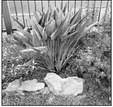Lacebug scourge is the likely cause of declining lantana plants
Dear Neil: I’ve had a few lantanas decline and die, and now the one on the left in my photo looks like it’s going. The one on the right looks fine. Water and sun were good.
The plant either needs more nitrogen or it needs help with lacebug control. If the pale color is uniform over the entire plant and over all leaf surfaces, that would be low nitrogen, and a watersoluble plant food should perk it up very suddenly. On the other hand, if the leaves are tan and mottled, and if you see small black specks on the backs of the leaves, they are infested with lacebugs, long the scourge of lantanas and many other garden plants. Most general- purpose insecticides will eliminate lacebugs but be sure you apply it to both top and bottom leaf surfaces. Spray in late evening after butterflies and bees have quit feeding for the day.
Dear Neil: Along with most in Texas, our St. Augustine lawn is burning up. That grass that gets some shade is faring better. There are bare spots exposed where there once was grass, but we see dead runners. This has been going on for several years. In the spring we have added new soil and new St. Augustine to the bare spots, but we just can’t seem to get the grass to take hold. Our lawn service fertilizes, uses pre-emergent weedkillers, and aerates the lawn. Is there another grass that would be better in the bare spots?
You covered everything except chinch bugs. They have done millions of dollars’ worth of damage to Texas St. Augustine again this summer just as they did last summer. So many people assumed their lawns were dying from heat and drought, when in reality, these small insects were sucking the lives right out of the grass. They show up in the hottest, sunniest parts of the yard and will come back to the same spaces year after year. You won’t see them in shady parts. Grass will look dry, but unless an insecticide is applied quickly, the grass will die out in large patches. They’ve also become a frequent problem for zoysia. Bermuda is less often bothered, so if that’s a grass you like, it might be a better choice if you opt not to treat for the chinch bugs. However, bermuda won’t tolerate as much shade.
Dear Neil: I thought my apple tree was too dry, but I found peeling bark and hard, white deposits on the base of the trunk. I can’t find any matching photos online. What might the problem be?
I can’t see any portion of the top of the tree. If there is any green foliage left, I’d be amazed. The trunk is decaying rapidly. The soil-borne fungus cotton root rot may have killed the tree, or there could have been some type of small branch that wasn’t removed properly farther up the trunk and decay might have settled in subsequently. In any event, the bark has come loose, and the wood of the trunk has dried out completely, hence the cracking. Apples aren’t easy in Texas, and I fear that yours is on its way out.
Dear Neil: I missed laying Zeon zoysia in my backyard in the spring. The yard has some spots with only three hours of sunlight, thus the Zeon. What is the latest time in fall that you would recommend planting it? I will be rototilling and laying down four inches of compost a few weeks before laying the sod.
I’ll answer your first question directly. I would want to plant zoysia sod at least two months before the average date of the first killing freeze in the fall. Of course, that will depend on where you are specifically. Google your county and ask for that information. My much bigger concern is the three hours of sunlight. Zoysias need six hours of direct sunlight to establish and grow. You might make it with five hours, but I’d certainly advise you to try a small planting of the Zeon for a couple of months before you make a big investment. I’ve seen so many people lose lots of money trying to grow grass in areas that are simply too dark. St. Augustine is more shadetolerant, although some people are trying to get away from it because of its water needs. You may be a candidate for a groundcover like mondograss (regular “monkeygrass”) in those shadier areas.
Have a question you’d like Neil to consider? E-mail him at mailbag@sperrygardens. com. Neil regrets that he cannot reply to questions individually.




